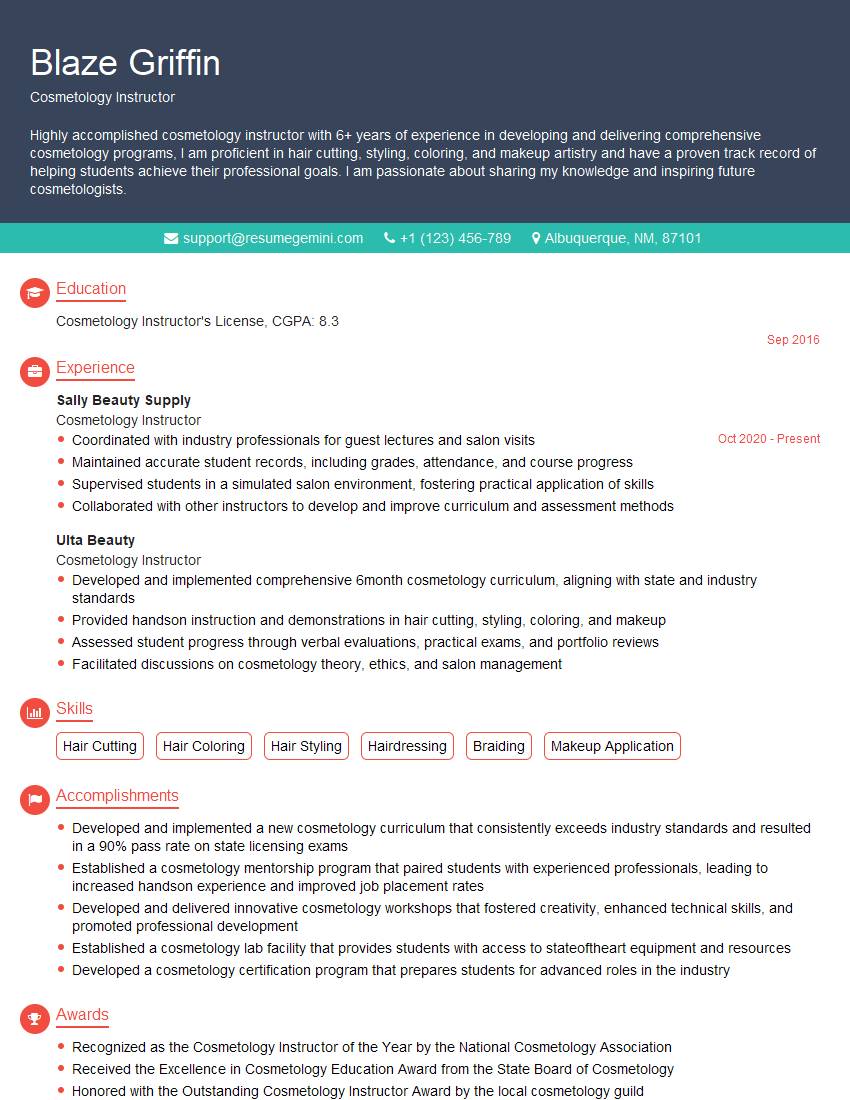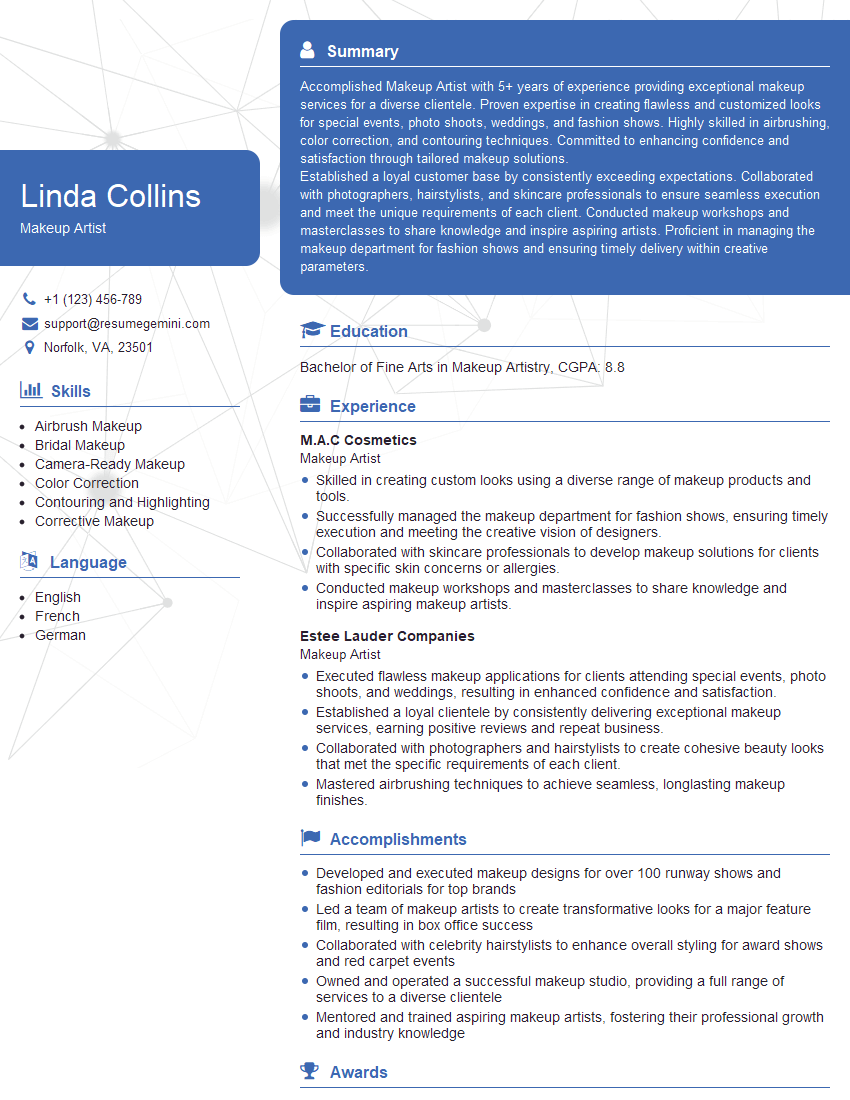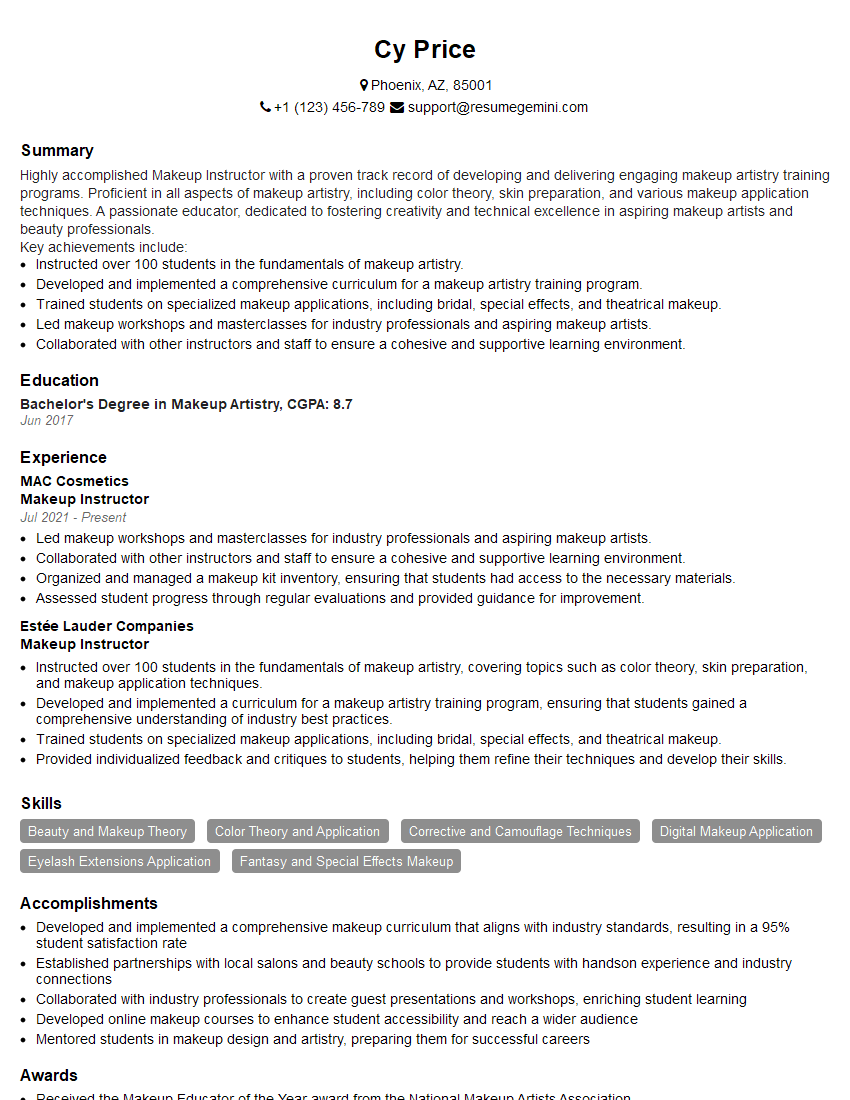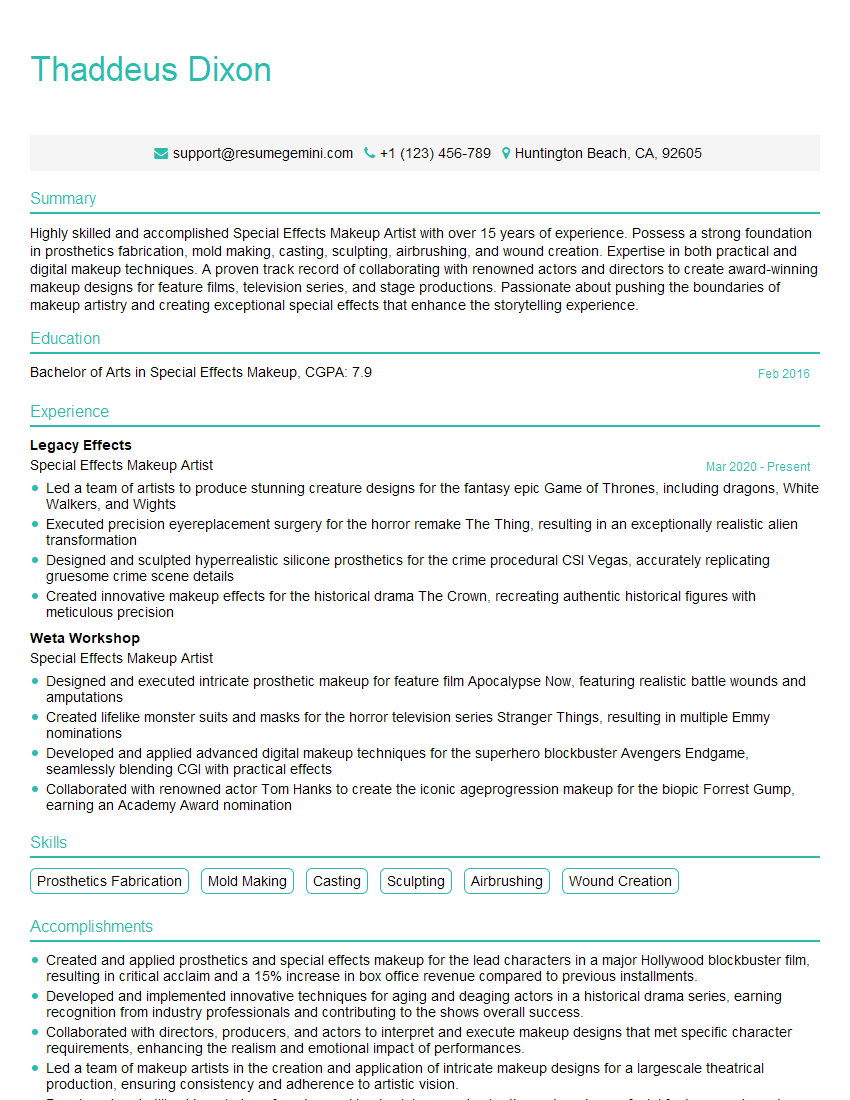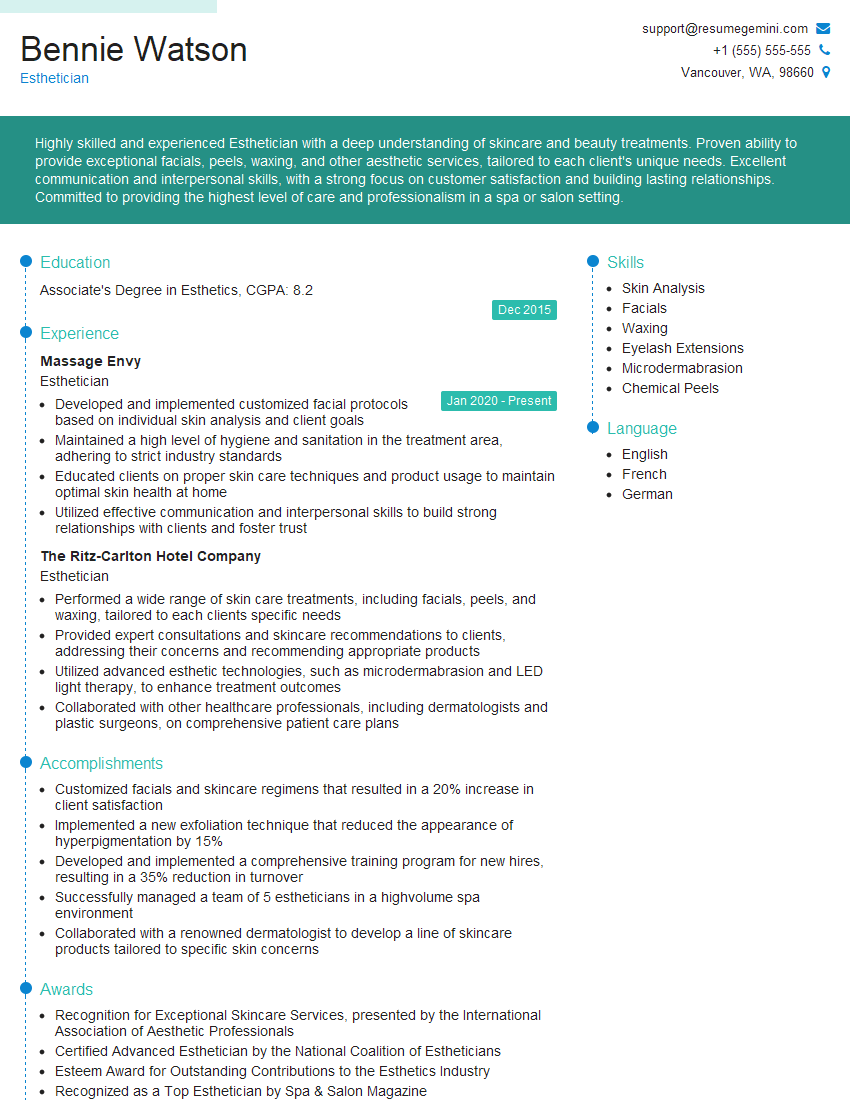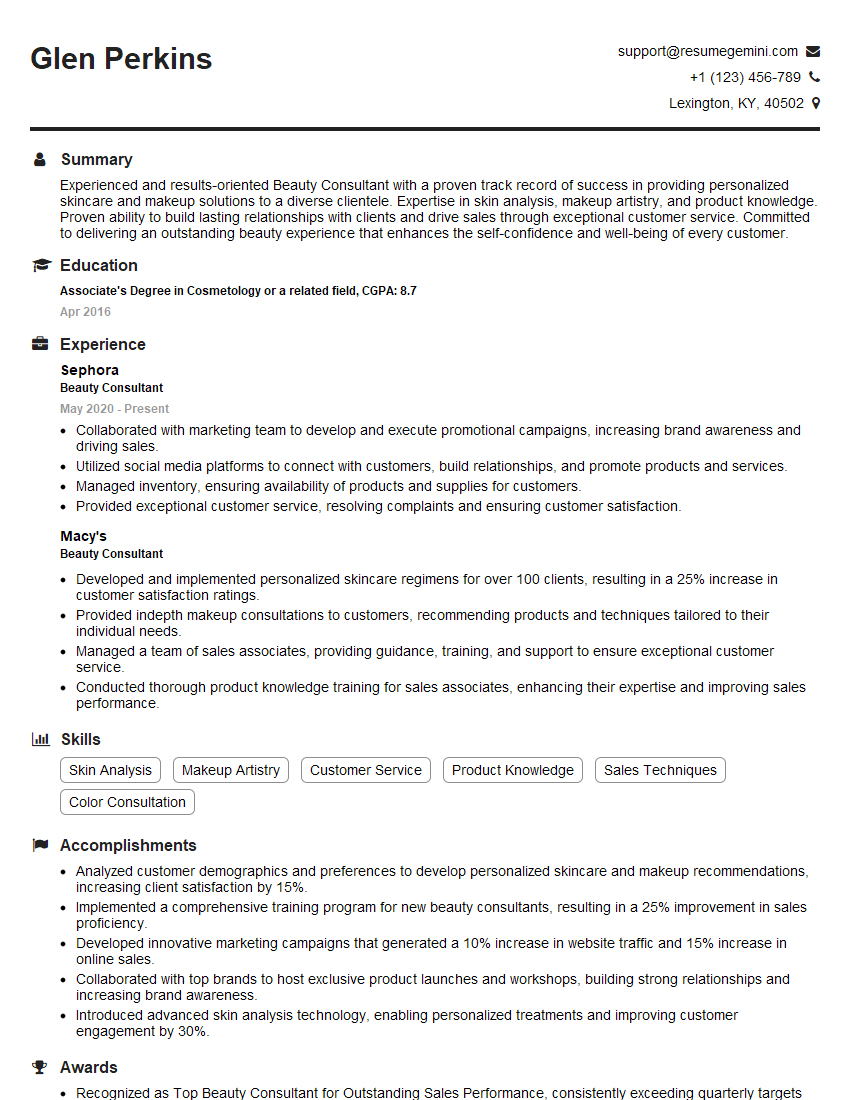Every successful interview starts with knowing what to expect. In this blog, we’ll take you through the top Make-up Design interview questions, breaking them down with expert tips to help you deliver impactful answers. Step into your next interview fully prepared and ready to succeed.
Questions Asked in Make-up Design Interview
Q 1. Describe your experience with different makeup application techniques (e.g., airbrush, sponge, brush).
My experience encompasses a wide range of makeup application techniques. Each method offers unique advantages and is best suited for different situations and desired effects.
- Brush Application: This is the most common technique, offering versatility and precision. Different brush shapes and sizes allow for precise application of various products, from blending eyeshadow to applying foundation. For example, a fluffy blending brush is perfect for softly diffusing eyeshadow, while a flat foundation brush delivers a more full-coverage look.
- Sponge Application: Sponges, particularly damp beauty blenders, provide a seamless, airbrushed finish. The damp sponge helps to sheer out the product, making it ideal for lightweight foundation application and achieving a natural look. However, sponges can absorb more product than brushes.
- Airbrush Application: Airbrush makeup delivers an incredibly even and flawless finish, making it perfect for high-definition photography or special events. It’s efficient and minimizes product waste, but requires specialized equipment and training. I’ve used it extensively for bridal makeup and runway shows where a perfect, long-lasting finish is crucial.
I am proficient in all three methods and can seamlessly adapt my technique based on the client’s needs, the occasion, and the desired makeup style.
Q 2. What are your preferred brands of makeup and why?
My preferred makeup brands are chosen based on quality, performance, and the range of shades offered to cater to diverse skin tones. I don’t exclusively stick to one brand but rather curate a kit based on specific product performance.
- Foundation: I frequently use brands like NARS and Estee Lauder for their wide shade ranges and buildable coverage. They offer formulas for various skin types, from oily to dry.
- Eyeshadow: I appreciate the pigmentation and blending capabilities of palettes from Anastasia Beverly Hills and Charlotte Tilbury.
- Blush & Highlighter: I find that brands like MAC and Rituel de Fille offer excellent quality and a wide selection of shades.
Ultimately, the best brand is subjective and dependent on the individual’s needs and preferences. My focus is always on selecting products that complement the client’s unique features and skin tone.
Q 3. Explain your process for creating a natural, everyday makeup look.
My process for a natural, everyday look prioritizes enhancing features rather than masking them. It’s all about creating a ‘your best skin’ effect.
- Skincare Prep: I always start with clean, moisturized skin. This ensures the makeup applies smoothly and lasts longer.
- Light Coverage Foundation/BB Cream: I use a lightweight foundation or BB cream, applying it sparingly with a damp beauty blender to achieve a natural finish. I focus on areas needing more coverage, like blemishes.
- Concealer (Optional): If needed, I use a small amount of concealer to brighten the under-eye area and cover any remaining imperfections.
- Blush & Bronzer: A touch of cream or powder blush adds warmth and definition to the cheeks, while a light dusting of bronzer sculpts the face.
- Mascara & Brows: I define the brows using a brow gel or pencil, then apply mascara for subtle definition.
- Lip Balm or Tinted Lip Gloss: A hydrating lip balm or tinted lip gloss completes the look.
This simple process creates a fresh, natural look suitable for everyday wear, emphasizing the client’s natural beauty.
Q 4. How do you adapt your makeup application to different skin tones and types?
Adapting makeup application to different skin tones and types is paramount. It requires understanding the unique characteristics of each and selecting products accordingly.
- Skin Tone: I choose foundation shades carefully, considering undertones (cool, warm, neutral) to achieve a perfect match. I always test foundation on the jawline in natural light. For darker skin tones, I use products formulated to avoid ashy or grey appearances. For lighter skin tones, I ensure products don’t look chalky or mask the natural radiance.
- Skin Type: For oily skin, I opt for mattifying primers and long-wearing foundations. For dry skin, I prioritize hydrating primers and creamy formulas. Sensitive skin requires hypoallergenic and fragrance-free products.
My expertise allows me to select the right products and techniques to ensure a flawless application that complements each client’s individual needs, resulting in a look that enhances, not overwhelms.
Q 5. Describe your experience with special effects makeup.
My experience with special effects makeup is extensive, ranging from theatrical productions to film work. It’s a completely different art form requiring a unique skillset.
I’m proficient in creating various effects, including:
- Wounds and Injuries: Using silicone prosthetics, latex appliances, and makeup techniques to create realistic-looking wounds, burns, and lacerations.
- Creature Design: Transforming individuals into fantastical creatures using body paint, prosthetics, and specialized makeup techniques.
- Character Makeup: Creating specific character looks based on design briefs, using a combination of techniques and materials to achieve the desired effect.
Safety and hygiene are paramount in special effects makeup, so I adhere strictly to industry-standard protocols when handling materials and applying products.
Q 6. How do you handle difficult clients or challenging makeup requests?
Handling difficult clients or challenging requests requires diplomacy, professionalism, and strong communication skills. My approach is always to listen actively and understand the client’s vision.
- Active Listening: I thoroughly discuss the client’s expectations, preferences, and any concerns they might have, ensuring a clear understanding before commencing the makeup application.
- Compromise and Collaboration: If a request seems unrealistic or might not suit the client’s features, I offer alternative suggestions while explaining the rationale behind my recommendations. The goal is a collaborative approach, resulting in a look both client and I are happy with.
- Professionalism: Maintaining a calm and respectful demeanor, even in challenging situations, is essential. I address concerns professionally and focus on resolving the issue, always putting the client’s satisfaction first.
Through open communication and a collaborative approach, I have successfully navigated many difficult situations, resulting in positive outcomes and satisfied clients.
Q 7. What are your strengths and weaknesses as a makeup artist?
My strengths lie in my adaptability, attention to detail, and ability to connect with clients. I can easily adapt my techniques and product choices to cater to diverse needs and preferences. I have a keen eye for detail, ensuring every element of the makeup is perfectly executed. I excel at building rapport with clients, creating a relaxed and comfortable atmosphere for them.
One area for continuous improvement is time management, particularly in high-pressure situations. I’m actively working on optimizing my workflow to balance speed and precision effectively. I’m also consistently expanding my knowledge of new products and techniques through ongoing education and workshops.
Q 8. What is your understanding of color theory and how it applies to makeup?
Color theory is the foundation of makeup artistry. It’s all about understanding how colors interact with each other – their relationships in terms of hue, saturation, and value – to create specific effects. In makeup, we use this knowledge to enhance features, create illusions, and harmonize the overall look.
For instance, understanding complementary colors (colors opposite each other on the color wheel, like blue and orange) is crucial. Using a complementary eyeshadow color can make the eyes pop. Applying a peachy blush (warm, complementary to cool-toned blue eyes) will make the blue stand out even more. Conversely, using analogous colors (colors next to each other on the color wheel, like blues and greens) creates a more harmonious and subtle look, perfect for a natural everyday makeup.
We also consider skin undertones. Someone with cool undertones will generally look better with cooler colors (think pinks and purples), while someone with warm undertones will be enhanced by warmer colors (peaches, corals, golds). Mastering color theory allows me to select the most flattering shades for each client, considering their skin tone, eye color, and hair color.
Q 9. Explain your knowledge of skincare and its relation to makeup application.
Skincare is paramount before makeup application. Healthy, well-cared-for skin provides a smooth, even canvas that allows makeup to apply flawlessly and last longer. It also prevents breakouts and irritation that can be caused by makeup products.
My process always begins with a skincare consultation. I assess the client’s skin type (oily, dry, combination, sensitive) and concerns (acne, dryness, wrinkles). I recommend a personalized skincare routine that includes cleansing, toning, and moisturizing, tailored to their specific needs. This might involve suggesting specific products, or simply advising on proper cleansing techniques.
For example, if a client has oily skin, I’d advise using a lightweight, oil-free moisturizer and a primer designed to control shine. Conversely, for dry skin, a hydrating moisturizer and a hydrating primer would be more appropriate. Proper skincare ensures the makeup looks its best and doesn’t exacerbate any existing skin conditions.
Q 10. How do you maintain hygiene and sanitation standards during makeup application?
Maintaining hygiene is non-negotiable in makeup artistry. It’s crucial for preventing the spread of infections and ensuring client safety. My sanitation practices adhere to the highest standards.
- Clean Brushes: I use clean brushes for each client, washing them thoroughly with brush cleaner after every use. I also regularly disinfect my brush holders.
- Disposable Applicators: I use disposable applicators like mascara wands and sponges whenever possible.
- Sanitized Tools: All tools that come into contact with skin (tweezers, etc.) are sanitized before and after each use.
- Hand Hygiene: I wash my hands thoroughly before and after each client, using antibacterial soap.
- Product Hygiene: I avoid double-dipping into products and always use clean spatulas to scoop out products.
By following these practices, I ensure a clean and safe environment for my clients, minimizing the risk of any infections or allergic reactions. It’s about professionalism and client well-being.
Q 11. Describe your experience working with different lighting conditions.
Experience with diverse lighting conditions is critical. Makeup that looks flawless in one light might appear completely different in another. My adaptability lies in understanding how lighting affects color perception and adjusting my techniques accordingly.
For example, in natural sunlight, colors appear brighter and more saturated. Therefore, I might use slightly less intense colors to avoid an overly made-up look. In contrast, under artificial indoor lighting (often warmer and less bright), I might need to use slightly more pigmented colors to ensure the makeup shows up well in photos and video.
I always take the time to analyze the lighting conditions before starting the makeup application and adapt my color choices and techniques to achieve the desired result regardless of the lighting. I also utilize color correcting techniques to counter any unwanted shadows or discolorations that may be created by particular lighting environments.
Q 12. How do you manage your time effectively during a busy makeup session?
Time management during busy sessions is crucial. My approach is organized and efficient. It relies on a combination of planning and prioritization.
- Detailed Consultation: A quick yet thorough initial consultation clarifies the client’s needs and desired look, reducing time spent on adjustments later.
- Organized Kit: My makeup kit is meticulously organized, allowing me to locate products swiftly, eliminating wasted search time.
- Prioritization: I prioritize essential steps first – foundation, eyes, etc. – to ensure that even if time is limited, the core look is completed.
- Efficient Techniques: I use quick and efficient application techniques while maintaining precision. Practice and experience help.
- Time Blocking: For large events or multiple clients, time blocking allows me to allocate specific time slots for each, preventing overruns.
This combined approach ensures that I can deliver high-quality makeup looks even under pressure, respecting my client’s time.
Q 13. What software or tools do you use for makeup design or planning?
While many makeup artists rely on their expertise and experience alone, I utilize digital tools to enhance my creative process and client communication. I use:
- Adobe Photoshop: For digital makeup design, experimenting with different color palettes, and creating mood boards for client consultations. I can also show a client what a look would look like on them before I actually apply it.
- Procreate (iPad App): This allows for quick sketches and color palette testing, useful for visualizing ideas quickly on the go. It’s easier and faster than using physical palettes.
- Pinterest/Instagram: I utilize these platforms to curate inspiration and share my work, staying up-to-date on current trends and techniques. They’re also useful for initial client consultations and mood boards.
These tools improve my efficiency and allow for more personalized and creative approaches. This collaborative approach, combining my artistry and the technological power of these tools, enhances my overall service.
Q 14. What is your process for creating a bridal makeup look?
Creating a bridal makeup look involves a unique combination of artistry and understanding the client’s vision. It’s a highly personalized process.
- Consultation: A detailed consultation is paramount, discussing the wedding theme, dress, and desired look. Understanding the bride’s personality and preferences is key.
- Skin Prep: Thorough skincare preparation is crucial. This involves cleansing, moisturizing, and priming the skin for a flawless base.
- Natural & Long-Lasting: The focus is on creating a natural, flawless look that lasts all day. Products are carefully selected for their longevity and blendability.
- Trial Run: A trial run before the big day allows adjustments and ensures the bride is entirely happy with the final look under various lighting conditions.
- Photography Consideration: The makeup needs to look stunning in photos, so I consider how different lighting and camera angles might affect the look.
- Airbrush Makeup (Optional): Airbrush makeup is a great option for creating a flawless, long-lasting finish and is often preferred for bridal looks.
Bridal makeup is about capturing the bride’s natural beauty while enhancing her features for a radiant and unforgettable look. It’s a collaboration, not just an application.
Q 15. Describe your experience with different makeup styles (e.g., glamorous, natural, dramatic).
My experience spans a wide range of makeup styles, each requiring a different approach and skill set. Glamorous makeup, for instance, focuses on enhancing features with bold colors, dramatic lashes, and a sculpted contour. Think of a classic Hollywood starlet – that’s the essence of glamorous makeup. I’ve executed this style countless times, adapting it to individual features and preferences. Natural makeup, conversely, prioritizes a flawless, ‘no-makeup’ look. This involves careful skin preparation, light coverage, and subtle highlighting and contouring to create a radiant and even complexion. I often use this style for bridal makeup or everyday looks. Dramatic makeup is where I get to showcase more artistic flair. It involves bolder choices – think intense smoky eyes, deep lip colors, or graphic eyeliner. I’ve done many avant-garde and theatrical looks for photoshoots and stage productions. The key across all these styles is understanding the client’s vision and adapting my techniques to achieve the desired effect.
Career Expert Tips:
- Ace those interviews! Prepare effectively by reviewing the Top 50 Most Common Interview Questions on ResumeGemini.
- Navigate your job search with confidence! Explore a wide range of Career Tips on ResumeGemini. Learn about common challenges and recommendations to overcome them.
- Craft the perfect resume! Master the Art of Resume Writing with ResumeGemini’s guide. Showcase your unique qualifications and achievements effectively.
- Don’t miss out on holiday savings! Build your dream resume with ResumeGemini’s ATS optimized templates.
Q 16. How do you ensure client satisfaction?
Client satisfaction is paramount. I achieve this through a multi-step process. First, a thorough consultation is essential. This isn’t just about choosing colors; it’s about understanding the client’s personality, style, event, and expectations. Then, I focus on meticulous application, paying attention to detail and ensuring the makeup looks and feels flawless. Throughout the process, open communication is key – I regularly check in to address any concerns and make adjustments as needed. Finally, I always offer post-application tips for maintenance and touch-ups, ensuring the client feels confident and prepared. I remember one client who was initially nervous for her wedding; by the end, she felt so radiant and confident, and that’s the reward I cherish most.
Q 17. Explain your understanding of current makeup trends.
Current makeup trends are dynamic. Right now, we’re seeing a blend of classic techniques with modern twists. Natural, dewy skin remains popular, but we’re moving away from heavy contouring towards softer, more blended looks. Bold brows are still in, but the focus is on shaping them to complement the individual’s features rather than creating overly harsh lines. In terms of colors, warm, earthy tones continue to be popular, but vibrant pops of color on the lips or eyes are also making a comeback. Skincare-infused makeup is huge, with foundations and concealers that offer skin-beneficial ingredients. Sustainability and ethical sourcing of products are also gaining importance. The overall trend emphasizes individuality and expressing one’s personality through makeup, avoiding a one-size-fits-all approach.
Q 18. How do you stay updated on the latest techniques and products in the makeup industry?
Staying updated requires a multi-pronged approach. I regularly attend industry workshops and masterclasses led by renowned makeup artists. Trade magazines and online platforms like YouTube and Instagram are invaluable resources, offering tutorials and insights into the newest techniques and products. I also actively follow leading makeup artists and brands on social media to stay abreast of trends and innovations. Finally, I actively participate in professional makeup groups and online forums, fostering a community of learning and knowledge sharing. Continuous learning keeps my skills sharp and ensures I can offer the latest and best to my clients.
Q 19. Describe your experience with working on photoshoots or video productions.
I have extensive experience in photoshoots and video productions. The key difference is the need for makeup that is both visually appealing on camera and long-lasting under studio lights. This often involves using HD-quality products and techniques that withstand close-ups and various lighting conditions. For instance, in video shoots, I need to consider how the makeup will look under different light temperatures and avoid products that might appear too shiny or powdery on camera. Collaboration with photographers and videographers is crucial to ensure the final result aligns with the overall vision of the production. I’ve worked on numerous projects, ranging from fashion editorials to commercial advertisements, gaining invaluable experience in adapting my skills to different settings and demands.
Q 20. How do you troubleshoot common makeup application problems?
Troubleshooting makeup application problems requires a systematic approach. For instance, if foundation looks cakey, it could be due to using too much product, poor skin preparation, or using the wrong formula for the client’s skin type. The solution could involve using a hydrating primer, applying a thinner layer of foundation, or switching to a lighter formula. If eyeshadow creases, it might be due to lack of primer or using a cream shadow without a setting powder. Here, a good eyeshadow primer and a light dusting of powder can solve the issue. Similarly, if lipstick bleeds, a lip liner and setting spray can help prevent this. The key is understanding the cause of the problem and applying the appropriate solution – often requiring a combination of product adjustments and technique modifications. This requires a deep understanding of product properties and application techniques.
Q 21. What is your experience with prosthetic application?
My experience with prosthetic application is limited, but I have completed a specialized course in this area, focusing on the application of simple prosthetics for character makeup. While I don’t routinely apply complex prosthetics, I am comfortable with the basic techniques of applying and blending prosthetics to create realistic effects. This involves careful skin preparation, accurate application of adhesives, and skillful blending with makeup to achieve a seamless and natural-looking result. This skillset adds another dimension to my abilities and opens up opportunities for more specialized projects.
Q 22. How do you create a specific character look using makeup?
Creating a specific character look with makeup involves a multifaceted approach that goes beyond simply applying color. It’s about telling a story through the face. I begin by thoroughly analyzing the character’s backstory, personality, and overall aesthetic as presented in the script, concept art, or director’s vision. This informs every decision, from color palette and texture to the placement of features and the overall intensity of the look.
For instance, if I’m creating a villainous character, I might utilize sharp lines, dark and intense colors (deep reds, dark purples, smoky grays), and perhaps incorporate elements like exaggerated contouring to create a more angular, harsh face shape. Conversely, a sweet and innocent character might receive softer features, lighter color palettes (pastel pinks, peaches, soft browns), and a more natural and dewy finish. I often use reference images to guide the process, but the key is to adapt and translate the essence of the character to the makeup, rather than directly copying a picture.
The process also involves considering the time period the character inhabits and the overall style of the production. For a period piece, I’d research historically accurate makeup techniques and styles, while a futuristic setting may inspire more avant-garde or experimental techniques, like using metallic pigments or unconventional shapes and lines.
Q 23. What is your experience with body painting?
My experience with body painting is extensive, encompassing both large-scale projects and intricate detail work. I’ve worked on everything from full-body transformations for theatrical productions and immersive experiences to more subtle, artistic body painting for editorial shoots and private events. I’m proficient in various techniques, including airbrushing, sponge application, and freehand painting, and I’m adept at working with a wide range of paints and mediums, ensuring both longevity and safety for the model’s skin.
One memorable project involved creating a living sculpture for an art exhibition. The piece required meticulous detail work, with intricate patterns and shading mimicking the texture and form of a natural rock formation. This project pushed my technical skills to their limits, requiring precision and patience. The success of that project highlighted the importance of understanding paint properties and skin sensitivities, alongside creative vision.
Beyond the technical aspects, I deeply value the collaborative nature of body painting. Effective communication with the model is crucial to ensure comfort, as well as accurately interpreting and executing the artistic vision.
Q 24. Describe your experience with designing looks for editorial shoots.
My experience in editorial makeup design for shoots is significant. I have a keen understanding of how makeup can enhance the overall aesthetic and narrative of a photograph. I collaborate closely with photographers, stylists, and art directors to develop concepts that complement the overall visual direction. This process often involves mood boards, detailed sketches, and sample palettes to ensure everyone is aligned on the final look.
In editorial work, the focus often shifts to creating looks that are both highly stylized and technically flawless. This requires a deep understanding of lighting, photography techniques, and the limitations (or possibilities) of the camera lens. I have a strong understanding of how different makeup techniques translate on camera and I’m skilled in making choices that enhance the photo’s impact rather than distracting from it. For instance, I would choose a matte finish for a powerful, edgy look while using a dewy base for a fresh, youthful look, understanding how each choice interacts with the lens and lighting.
I have worked with both established and emerging photographers on a variety of high-profile publications and brands, consistently delivering high-quality and creative results.
Q 25. How do you work collaboratively with other professionals on a team?
Collaboration is fundamental to my approach. I believe in fostering a positive and communicative environment where every team member feels valued and respected. On set or during events, I consistently engage in proactive communication, ensuring that my work aligns seamlessly with the overall vision of the photographer, stylist, hair artist, and the client. This involves actively listening to their input, offering my professional expertise, and being open to feedback and adjustments.
For instance, during a recent fashion shoot, the stylist had a specific vision for the overall look that differed slightly from my initial interpretation. Instead of sticking rigidly to my initial plan, I actively engaged in a discussion, incorporating her suggestions to create a cohesive look that satisfied everyone involved. The final result was a striking look that highlighted the collaboration and mutual respect within the team.
My collaborative style extends to managing expectations and providing clear and timely communication regarding timelines, resource needs, and potential challenges. I believe that open dialogue and mutual respect are key to achieving the best possible results.
Q 26. What is your salary expectation?
My salary expectation is commensurate with my experience and expertise in the field of makeup artistry and design. Considering my extensive portfolio, demonstrated ability in both editorial and body painting, and consistent delivery of high-quality results, I am seeking a competitive compensation package within the range of [Insert Salary Range Here]. I am open to discussing this further based on the specifics of the role and its responsibilities.
Q 27. Describe a time you had to problem-solve a makeup issue on set or during an event.
During a high-profile runway show, just moments before the models were scheduled to walk, one model experienced an allergic reaction to a newly-applied foundation. Her face started to become red and irritated. This was a critical situation; a delay would have jeopardized the entire schedule.
Immediately, I acted calmly and assessed the situation. I first removed the problematic foundation using a gentle cleanser and applied a soothing aloe vera gel to calm the irritation. Simultaneously, I communicated with the show’s coordinator about the delay and the need for a replacement foundation that was hypoallergenic and matched the model’s skin tone. Fortunately, I had several options in my kit. Within minutes, I was able to apply a suitable hypoallergenic foundation, concealing any remaining redness and ensuring the model was ready to go on time. The entire ordeal was resolved quickly and efficiently, preventing any significant disruption to the show.
This experience underscored the importance of being prepared for unexpected challenges, having a well-stocked kit with backup products, and effectively managing stressful situations under pressure.
Q 28. How do you handle constructive criticism?
I value constructive criticism and view it as an opportunity for growth and improvement. I believe in actively seeking feedback to hone my skills and refine my creative process. When receiving criticism, I approach it with an open mind, focusing on understanding the points made and how I can use this information to enhance my future work.
Instead of viewing criticism as personal attack, I see it as an objective evaluation that allows me to gain valuable insights into my strengths and weaknesses. I typically ask clarifying questions if something is unclear and then actively consider how to address the feedback. I document the feedback and actively try to integrate those suggestions into subsequent projects. This proactive approach allows me to continually improve my craft and consistently exceed expectations.
Key Topics to Learn for Make-up Design Interview
- Color Theory and Application: Understanding color palettes, harmonies, and their impact on different skin tones and features. Practical application includes creating a cohesive look based on client needs and occasion.
- Face Shapes and Features: Mastering techniques to enhance and contour different face shapes, highlighting individual features. Practical application involves adapting makeup techniques to suit various clients.
- Product Knowledge: Familiarity with various makeup products (foundation, concealer, eyeshadow, etc.), their properties, application methods, and brand differences. Practical application includes selecting and using appropriate products for various skin types and makeup styles.
- Skincare and Preparation: Understanding skin types, concerns, and appropriate pre-makeup skincare routines. Practical application includes preparing the skin for optimal makeup application and longevity.
- Different Makeup Styles: Proficiency in creating various makeup looks (natural, glam, bridal, etc.). Practical application involves tailoring makeup to specific events and client preferences.
- Hygiene and Sanitation: Understanding and implementing proper hygiene practices to maintain a clean and sanitary workspace. Practical application includes proper tool cleaning and sanitation protocols.
- Client Consultation and Communication: Developing effective communication skills to understand client needs and preferences. Practical application includes actively listening to client requests and offering personalized recommendations.
- Trend Awareness: Staying updated on current makeup trends and techniques. Practical application includes incorporating new trends into your work while maintaining professional standards.
Next Steps
Mastering Make-up Design opens doors to exciting career opportunities in diverse settings, from salons and studios to the fashion and film industries. A strong resume is your key to unlocking these prospects. Creating an ATS-friendly resume is crucial for getting your application noticed by recruiters. To help you build a compelling and effective resume, we highly recommend using ResumeGemini. ResumeGemini offers a user-friendly platform to create professional resumes, and we provide examples of resumes tailored specifically to Make-up Design to guide you.
Explore more articles
Users Rating of Our Blogs
Share Your Experience
We value your feedback! Please rate our content and share your thoughts (optional).
What Readers Say About Our Blog
Hello,
We found issues with your domain’s email setup that may be sending your messages to spam or blocking them completely. InboxShield Mini shows you how to fix it in minutes — no tech skills required.
Scan your domain now for details: https://inboxshield-mini.com/
— Adam @ InboxShield Mini
Reply STOP to unsubscribe
Hi, are you owner of interviewgemini.com? What if I told you I could help you find extra time in your schedule, reconnect with leads you didn’t even realize you missed, and bring in more “I want to work with you” conversations, without increasing your ad spend or hiring a full-time employee?
All with a flexible, budget-friendly service that could easily pay for itself. Sounds good?
Would it be nice to jump on a quick 10-minute call so I can show you exactly how we make this work?
Best,
Hapei
Marketing Director
Hey, I know you’re the owner of interviewgemini.com. I’ll be quick.
Fundraising for your business is tough and time-consuming. We make it easier by guaranteeing two private investor meetings each month, for six months. No demos, no pitch events – just direct introductions to active investors matched to your startup.
If youR17;re raising, this could help you build real momentum. Want me to send more info?
Hi, I represent an SEO company that specialises in getting you AI citations and higher rankings on Google. I’d like to offer you a 100% free SEO audit for your website. Would you be interested?
Hi, I represent an SEO company that specialises in getting you AI citations and higher rankings on Google. I’d like to offer you a 100% free SEO audit for your website. Would you be interested?
good
